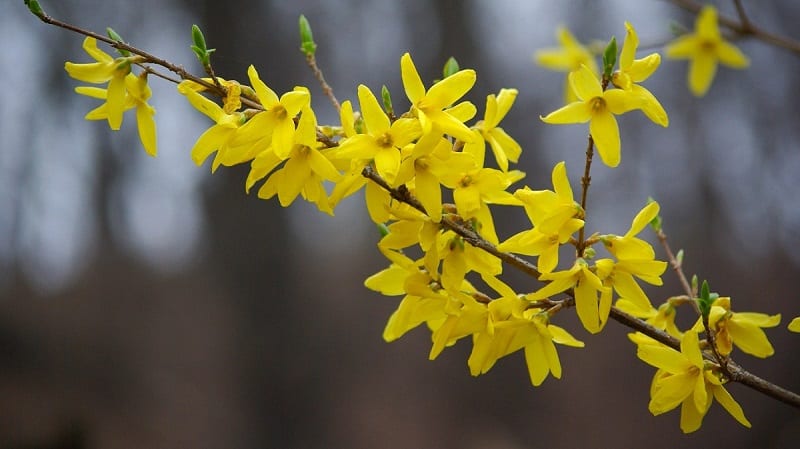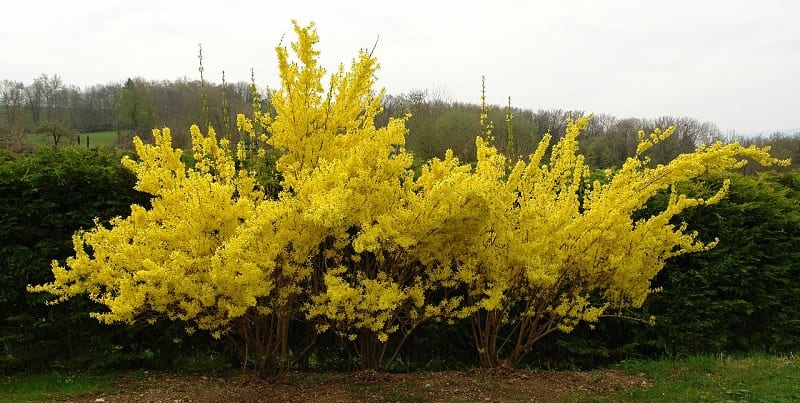The lively yellow blooms of the golden forsythia herald the arrival of spring. Their cheerful colour and appearance are among the reasons why the plant is a mainstay in many gardens.
If you love them as much as we do, you can use stem cuttings from your shrub to grow forsythia plants. You can employ the same strategy for other blooming woody shrubs, including clematis and mock orange.

Flourishing Beauty: The Advantages of Growing Forsythias
Contents
Forsythias, with their radiant yellow blossoms and graceful arching branches, are celebrated symbols of spring’s arrival and heralds of new beginnings. Beyond their captivating beauty, these versatile shrubs offer a multitude of advantages for gardeners and landscapes alike.
In this exploration, we delve into the numerous benefits and advantages of growing forsythias, from their resilience and ease of care to their ecological contributions and aesthetic appeal.
1. Resilience and Hardy Nature
Forsythias are renowned for their resilience and adaptability, thriving in a wide range of climates and soil conditions. From urban gardens to rural landscapes, these hardy shrubs can withstand heat, cold, drought, and even pollution, making them ideal choices for gardeners seeking low-maintenance plants that can endure various environmental challenges.
Their ability to tolerate diverse growing conditions ensures that forsythias can flourish in a variety of settings, from sunny gardens to shaded corners, adding beauty and vibrancy to landscapes with minimal effort.
2. Early Spring Bloomers
One of the most beloved features of forsythias is their early spring bloom, which signals the end of winter’s dormancy and the onset of warmer weather. These cheerful shrubs burst into a profusion of golden-yellow flowers before most other plants awaken from their winter slumber, brightening gardens and lifting spirits with their vibrant hues.
The early flowering period of forsythias makes them invaluable additions to landscapes, providing much-needed colour and visual interest during the transition from winter to spring.
3. Easy Propagation and Versatility
Forsythias are remarkably easy to propagate, making them accessible to both novice and experienced gardeners. Stem cuttings taken in early summer can root quickly and easily, allowing gardeners to propagate new plants with minimal effort.
Their versatility extends beyond their ease of propagation, as forsythias can be trained into various shapes and forms, including hedges, borders, espaliers, and standalone specimens. Their graceful arching branches lend themselves well to creative pruning and shaping, enabling gardeners to tailor their growth to suit specific landscape designs and preferences.
4. Wildlife Habitat and Ecological Benefits
Forsythias provide valuable habitat and food sources for wildlife, attracting pollinators such as bees, butterflies, and hummingbirds with their abundant nectar-rich flowers. These pollinators play essential roles in ecosystem health and biodiversity, making forsythias valuable contributors to ecological balance.
Additionally, forsythias offer shelter and nesting sites for birds and small mammals, enhancing biodiversity and supporting local wildlife populations. Their dense foliage and branching structure provide cover and protection from predators, creating havens for wildlife in urban and suburban environments.
5. Low Maintenance and Longevity
One of the greatest advantages of growing forsythias is their low maintenance requirements and long lifespan. Once established, these hardy shrubs require minimal care, thriving in a variety of soil types with little to no fertilization or pruning.
Forsythias are also long-lived plants, with many specimens living for decades or even centuries under optimal growing conditions. Their longevity ensures years of beauty and enjoyment for gardeners, providing reliable performance and enduring charm throughout the seasons.
The advantages of growing forsythias are abundant and diverse, making them invaluable assets to gardens and landscapes around the world. From their resilience and adaptability to their early spring blooms and ecological contributions, these versatile shrubs offer myriad benefits for both gardeners and the environment.
Whether adorning urban gardens, rural landscapes, or public parks, forsythias continue to captivate hearts with their flourishing beauty and enduring appeal.
Grow Forsythias from Stem Cuttings
Beyond its dramatic springtime announcement, forsythia is useful in the garden as a fast-growing hedge. The plant can grow 12 feet wide by 10 feet high, gaining as much as 24 inches in a year.
Here’s how you grow forsythia from stem cuttings.
1. Collect Spring Cuttings
Take spring cuttings from new plant growth as soon as forsythia comes into the leaf. You’ll find the new-growth stems on the outer edges of the plant. They are green and flexible, with small leaves reaching to the tip of the stem.
Be sure to clean your knife or clippers with alcohol or a mixture of one part chlorine bleach to nine parts water. Clean the blades again after each cut to avoid spreading disease.

2. Grow Medium and Moisture
Fill the planting pot with moistened coarse sand or a mixture of 50 percent perlite and 50 percent peat moss. Professionals advise against using vermiculite alone because it holds too much water.
Pinch off the bottom leaves of each stem to a height of 3 inches then insert the leafless end of the stem into the planting medium.
Cover the stems with a bottomless milk jug or a domed clear cover. This will ensure consistent moisture for the rooting stems. Place the pot in a warm-to-slightly-cool indoor location with indirect light.
Remove the dome daily to check the soil for moisture. Do not allow the cutting to dry out. Spritz the potting medium’s surface with water as needed. Keep it evenly moist but not soggy. Mist the cutting every day.

3. Check for Rooting Progress
You can check for rooting progress in about six weeks. Gently tug the cutting’s stem upward. If you feel some resistance, then rooting has begun. If the cutting pulls easily out of the soil, replace and check again in a couple of weeks.
The length of time the plant requires to establish roots will depend on growing conditions. In some places, you may need anywhere from a month to fullly grow forsythias.

4. Plant Forsythia
You can grow forsythias in early fall. This will allow them enough time to establish roots in the soil before they go into dormancy at the end of October.
You can also keep pots sheltered and mulched through fall and winter. Your new plants can go into the ground in late winter or early spring – as soon as the ground can be worked after the last frost.
Some growers advise placing larger cuttings – from current growth after spring blooming – directly into the soil.
However, this strategy depends largely upon local growing conditions. Check with your local extension service to see how well it would work in your area.
Your extension office can also provide advice on whether adding a rooting hormone to your plantings is necessary.

5. Care for Forsythias
Make sure your forsythia bush gets at least six hours of sunlight a day. You can grow forsythias with less than this, but too little sun will reduce its ability to flower.
When you grow forsythias, you also need well-draining soil that’s rich in organic matter. They do not grow well in wet, marshy, or swampy soil. Apply a layer of mulch around your forsythia shrub to ensure proper moisture.
When you try to grow forsythias, they should receive at least 2 inches of water a week. You should also fertilize the soil with a balanced fertilizer once every two to three months in the spring and summer. Do not fertilize in the fall and winter.
When you grow forsythias, prune yearly. Without pruning, these fast-growing shrubs can quickly become overgrown. The best time to prune forsythia shrubs is right after the plant has finished blooming.
The care for forsythia bushes is both easy and necessary. With proper care, your forsythia plant will dazzle you with a beautiful display of yellow flowers in the spring.
Wrapping It Up
Growing forsythias from stem cuttings is a rewarding endeavour that allows gardeners to propagate these vibrant shrubs and enjoy their cheerful blooms in their own landscapes. By following the five easy steps outlined in this guide, gardeners can successfully grow forsythia cuttings and watch them become healthy, thriving plants.
From selecting and preparing the cuttings to providing optimal growing conditions, each step plays a crucial role in ensuring the success of the propagation process. With proper care and attention, gardeners can experience how to grow forsythias and witness their beauty in the gardens.
Frequently Asked Questions
1. How long does it take to grow forsythia from stem cuttings?
Forsythia cuttings typically take around 4 to 6 weeks to develop roots under optimal conditions. However, root development may vary depending on factors such as temperature, humidity, and the health of the cuttings. It’s important to be patient and provide consistent care when you try to grow forsythias.
2. Can you propagate forsythias from cuttings at any time of the year?
While forsythia cuttings can be taken at various times of the year, the ideal time to grow forsythias is in late spring or early summer when the plants are actively growing. During this period, the stems are more likely to root successfully, leading to higher propagation success rates.
3. Do you need to use rooting hormone when you grow forsythias from cuttings?
While rooting hormone is not strictly necessary when you grow forsythias from cuttings, it can help promote faster root development and increase the chances of success. Using a rooting hormone powder or gel can encourage the growth of adventitious roots, leading to stronger and healthier plants.








